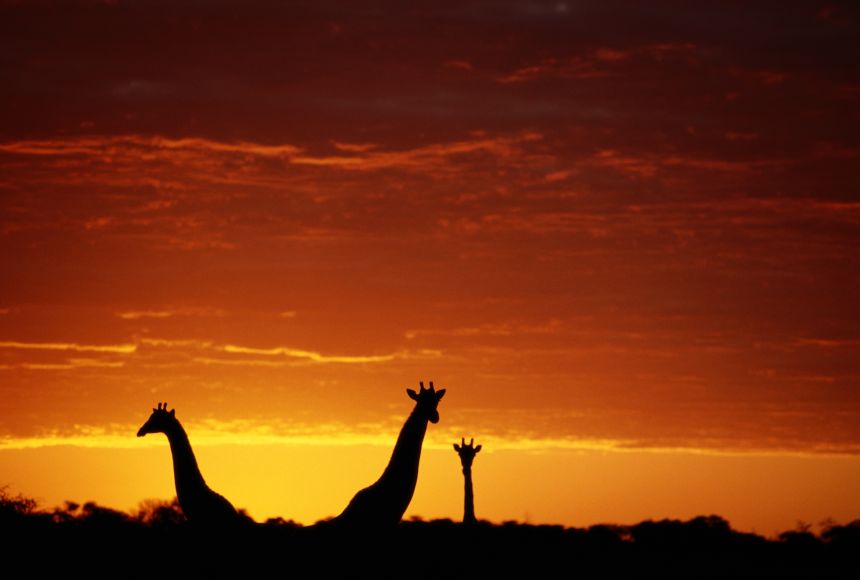In the northwestern region of the African country of Botswana, in the northernmost part of the Kalahari Desert, lies an oasis called the Okavango Delta. The United Nations Educational, Scientific and Cultural Organization (UNESCO) World Heritage Centre and the Ramsar Convention on Wetlands of International Importance have deemed the Okavango Delta a site worthy of protection.
The Okavango Delta is home to almost 2,000 plant and animal species that depend on the habitats of the delta for survival. Many threatened and endangered species, including the African wild dog (Lycaon pictus), the southern ground-hornbill (Bucorvus leadbeateri), the black rhinoceros (Diceros bicornis), and the white rhinoceros (Ceratotherium simum), call this inland delta their home.
In addition to these animal populations, more than 100,000 people live in and around the Okavango Delta and depend on the resources it provides. The Okavango Delta Peoples of Botswana consist of five distinct ethnic groups: the Bugakwe, Dxeriku, Hambukushu, Wayeyi, and Xanekwe. Most people live on the outskirts of the delta, leaving huge uninhabited areas within it. Historically, some of these groups were grain farmers; others relied on hunting, gathering, and fishing to survive. Today, these indigenous groups continue to rely on subsistence farming, fishing, and other activities that have little impact on the environment or its ecosystems. There are, however, several other factors that threaten the integrity of the delta, including overdevelopment and poaching.
Water and Land Threats
The government of Botswana protects the land within Okavango Delta, but environmentalists worry that farming and industry just beyond its borders could have devastating impacts.
One concern is water abstraction, or the removal of water for human use. Although abstraction from the upper part of the delta is not a major concern, increasing industrial demands pose a threat for the future. For example, Angola, which is north of Botswana and where the water in the delta originates, is planning a major initiative to increase commercial agricultural operations. This initiative would draw water from the Okavango Delta and possibly affect the surrounding environment. There are mechanisms in place, however, to protect the water supply to the delta. If Angola, Botswana, or Namibia wants to divert water from the Okavango River before it reaches the delta, their plans need to be approved by the Permanent Okavango River Basin Water Commission (OKACOM). OKACOM’s mission is to promote economic prosperity, social justice, and environmentally conscious development of the Cubango-Okavango River Basin. To accomplish OKACOM’s mission, all stakeholders need to work together to find a balance between supporting increased agriculture in the region and preserving the integrity of the delta.
Oil drilling is another concern. Local leaders say that an oil exploration company in Namibia has bulldozed forests and damaged protected animal conservancies within the delta without the knowledge or consent of local governments. There is also concern that spills from oil pipelines would damage the waterways, as spills can often spread far past their point of origin.
Poaching Threat
Poaching is a complex topic, and poachers hunt animals for reasons beyond simple economic gain. Thanks to conservation efforts, the population of African bush elephants (Loxodonta africana) in the delta has exploded. This can present problems for surrounding populations, as elephants that leave the protected land can destroy local crops and threaten the livelihoods of farmers, many of whom already live below the poverty line. Although rare, elephants have also been known to attack and even kill people. The residents near protected lands often view poaching as the only way to protect themselves and their crops. Others poach elephants, giraffes, and other animals to make bushmeat, which is then eaten or sold. As the population has increased and people have remained in poverty, demand for and prices of bushmeat have gone up, increasing the incentive for poaching.
Not all poachers are inhabitants of the region. Local agencies report that many of the poachers who target rhinoceroses come to the delta from foreign countries, such as Zambia, and sell their wares on an underground, but well-organized, international market. These foreign poachers come to the area because of the high demand in some places of the world for rhinoceros horn, which some cultures believe to have medicinal properties. Additionally, although the sale of ivory is illegal in many places, in parts of Asia, there remains demand for elephant tusks to make jewelry and other items.
Combating poaching in the Okavango Delta will take joint efforts from a variety of sectors and both local and national governments. Some experts suggest that incentivizing the local community to become invested in the protection of wildlife would help decrease local poaching activity. This can mean sharing profits gained by preserves with the community or training and hiring more local members to work on preserves. Since many poachers have wilderness skills, they may be good candidates for legal jobs as wildlife managers.
Foreign governments and concerned citizens can also play a role in reducing demand for goods made from poached animals. Some experts suggest that increasing the availability of legal ivory and rhinoceros horns would weaken the underground market. Several countries in Asia are using marketing campaigns to decrease demand for ivory or other goods obtained from illegal poaching. There is evidence that these kinds of marketing campaigns can be effective in changing people’s opinions.
There is Still Time
The Okavango Delta’s vast expanse of swamps and grasslands is a unique environment that needs protection to survive in the modern world. With proper management, there is still hope to continue the preservation of this distinctive wilderness and its diversity of life.
